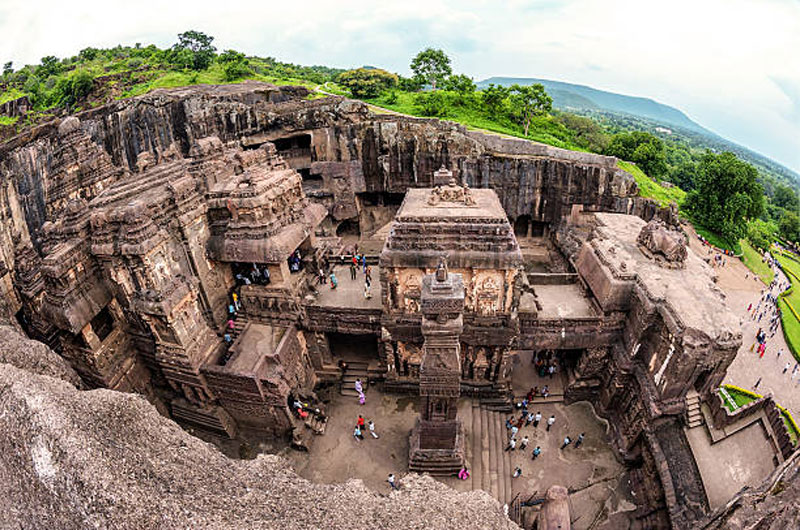
Ellora Caves: The Confluence of Religions – A World Heritage Site
The Ellora Caves, a UNESCO World Heritage Site, are a series of rock-cut caves located in Maharashtra, India. These caves, carved into the Charanandri hills, date back to 600-1000 CE and are known for their architectural brilliance and artistic significance. Ellora is unique as it showcases the coexistence of Buddhism, Hinduism, and Jainism in a single complex, reflecting the religious tolerance and cultural diversity of ancient India.
Historical Background
- Origins and Construction
- Constructed between the 6th and 10th centuries CE.
- Developed under the patronage of the Rashtrakuta, Kalachuri, and Yadava dynasties.
- Represents a significant era in Indian history where different religious communities coexisted peacefully.
- Cultural and Religious Significance
- A center of pilgrimage for Buddhists, Hindus, and Jains.
- Highlights the artistic and cultural exchange between different religious communities.
Architectural Marvel
- Design and Structure
- Consists of 34 caves: 12 Buddhist, 17 Hindu, and 5 Jain caves.
- Carved out of solid basalt rock using chisels and hammers.
- Notable Caves
- Cave 16 (Kailasa Temple): The most famous structure, dedicated to Lord Shiva, resembling Mount Kailash. It is a free-standing, multi-storey temple complex carved out of a single rock.
- Cave 10 (Vishvakarma Cave): Known as the Carpenter’s Cave, features a large seated Buddha and is notable for its cathedral-like stupa hall.
- Cave 12 (Teen Thal): A three-storey Buddhist cave with intricate sculptures and a large central shrine.
- Cave 32 (Indra Sabha): The largest Jain cave, with detailed carvings and beautiful statues of Jain Tirthankaras.
- Cave 21 (Rameshvara Cave): Features elegant carvings and a sanctum with a linga, representing Lord Shiva.
- Artistic Excellence
- Intricate sculptures depicting various deities, mythological scenes, and everyday life.
- Detailed frescoes and carvings reflecting the artistic mastery of the period.
Specialty of Ellora Caves
- Religious Diversity
- Unique for its representation of three major religions: Buddhism, Hinduism, and Jainism.
- Reflects the spirit of religious tolerance and cultural harmony in ancient India.
- Architectural Brilliance
- Exemplifies the zenith of rock-cut architecture.
- Kailasa Temple is considered one of the largest monolithic structures in the world.
- Cultural Significance
- Represents the confluence of different cultural and artistic traditions.
- Highlights the patronage of art and religion by ancient Indian rulers.
Tourism Aspects
- Visitor Experience
- Guided tours available in multiple languages.
- Informative plaques and audio guides for self-paced exploration.
- Well-maintained pathways and viewing platforms for a comfortable visit.
- Nearby Attractions
- Ajanta Caves: Another UNESCO World Heritage Site, located about 100 kilometers from Ellora, known for its ancient Buddhist rock-cut caves.
- Daulatabad Fort: A historic fort near Ellora, offering panoramic views and a rich history.
- Grishneshwar Temple: One of the 12 Jyotirlinga shrines dedicated to Lord Shiva, located near Ellora.
- Events and Festivals
- Ellora Festival: An annual cultural festival featuring classical music and dance performances.
- Makar Sankranti: A major Hindu festival celebrated with kite flying and cultural events.
Impact on Locality
- Economic Significance
- Major contributor to the tourism industry in Maharashtra.
- Provides employment opportunities for local guides, vendors, and artisans.
- Cultural Influence
- Enhances community pride and historical awareness.
- Promotes the preservation of traditional crafts and cultural heritage.
Preservation and Challenges
- Conservation Efforts
- Managed by the Archaeological Survey of India (ASI).
- Ongoing restoration and maintenance to preserve the structural integrity and artistic value.
- Environmental Concerns
- Impact of natural weathering and environmental degradation.
- Measures to control visitor impact and ensure sustainable tourism practices.
Conclusion
The Ellora Caves stand as a monumental testament to the architectural brilliance and religious harmony of ancient India. As a UNESCO World Heritage Site, they not only attract tourists and scholars worldwide but also underscore the rich cultural heritage of India. The ongoing efforts to preserve and protect these iconic caves ensure that they continue to inspire awe and admiration for generations to come.
